Trump’s War Against Transparency And The Free Press Continues
It's been three months since the White House held a press briefing. Meanwhile, the President continues his unhinged attacks on the media.

A White House reporter for The Washington Post is speaking out about the Trump Administration’s apparent policy that has resulted in what basically amounts to the end of the daily press briefing by the White House Press Secretary:
A Washington Post reporter criticized the lack of media briefings from the White House by comparing the James S. Brady Press Briefing Room to a Blockbuster video store that is “dusty, cobwebbed and abandoned.”
The White House has “a very nice room for press briefings located just a few steps from the driveway,” wrote Washington Post media reporter Paul Farhi in a story published on Sunday about White House press secretary Sarah Huckabee Sanders using the White House driveway to address reporters instead of a more formal setting.
“But these days, the James S. Brady Press Briefing Room is like a Blockbuster video store: dusty, cobwebbed and abandoned,” he wrote.
The perspective comes more than two weeks after CNN reporter Maegan Vazquez took a photo of the briefing room podium to show it gathering dust.
“The White House hasn’t held press briefing in so long that the lectern in the briefing room is quite literally gathering dust,” Vazquez tweeted on May 17.
Sanders’s last press briefing occurred on March 11, where she was asked about the lack of press briefings.
The White House responded to a request for comment from The Hill by referring to previous remarks on the subject made by Sanders at that briefing.
“I know the president is the most accessible president in modern history,” Sanders said at the time. “He takes questions from you guys nearly every single day.”
Trump has often spoken to reporters in what’s referred to as “gaggles” outside the White House in recent months.
Washington Post media reporter Paul Farhi wrote about this issue in Sunday’s edition:
It’s a warm spring morning in Washington, and once again the blacktop at the White House is starting to heat up. People lugging cameras, microphones and notepads are scrambling to get into place. There is milling, so much milling.
Sarah Sanders is about to speak.
As usual, President Trump’s press secretary is brief — just a few comments dismissing pro-impeachment Republican Rep. Justin Amash (Mich.) — but it’s the setting, not what’s said, that may be more significant: Sanders makes her comments to a group of journalists assembled on the White House’s north driveway, a stretch of asphalt that runs from Pennsylvania Avenue to the president’s home and office — about the length of a fast-food drive-through lane.
For months, the driveway has become the informal locale for interviews with administration officials. While Trump prefers to engage reporters amid Marine One’s whirring helicopter blades on the White House’s South Lawn, the north driveway has become the only place to grab Sanders or officials such as White House counselor Kellyanne Conway for a few on-camera comments.
The White House, of course, has a very nice room for press briefings located just a few steps from the driveway. But these days, the James S. Brady Press Briefing Room is like a Blockbuster video store: dusty, cobwebbed and abandoned. The last time Sanders showed up for a press briefing there was 83 days ago , a record period for not briefing the press. She established the previous record (43 days) in March — which broke the record she set in January. The Pentagon and State Department have all but abandoned press briefings, too, in what amounts to a semiofficial policy of avoiding and diminishing the press.
Nowadays Sanders only shows up for driveway drive-bys, many of which last no more than five or six minutes and are held seemingly by chance.
Correspondents have complained about these informal sessions to Sanders, to no avail. (The White House Correspondents’ Association hasn’t formally protested, according to its president, Olivier Knox.) After one driveway mini-press conference last week, a Bloomberg News White House reporter, Margaret Talev, trailed the press secretary as she walked back to the West Wing, asking why the White House couldn’t move the Q&As into the briefing room and out of the 90-degree heat, according to reporters who witnessed the encounter. She apparently received no answer. (Talev declined to comment for this story; Sanders didn’t respond at all).
But the basic gripe about the gaggles, as they’re known, isn’t about the weather; it’s their brevity and impromptu nature.
“Certainly the ad hoc nature of the driveway gaggle makes our jobs more challenging compared to being able to prepare for a pre-announced briefing in the Brady Room,” said Steve Herman, White House bureau chief for VOA News. “Is this arrangement more beneficial for the administration? I don’t know. There’s certainly a more random nature to it, and this administration has no qualms about breaking with tradition.”
In fact, there’s no schedule, no set topics and no established duration to the driveway meetups. They occur essentially at random, or rather whenever Sanders or Conway are done giving another exclusive interview to Fox News on “Pebble Beach,” the gravelly patch off the driveway where White House TV correspondents do their “stand ups,” or live reports.(…)
Though brief and irregular, the driveway interviews are often the only chance to capture video footage of an administration official talking about the news of the day, which makes them critical for TV correspondents.
But if the administration’s aim is to downplay the role of the press, the driveway strategy may be working, some reporters say.
“I think it gives them an element of control,” said Brian Karem, a CNN contributor who covers the White House for Playboy magazine. “It’s harder to [ask] follow-ups. It is harder to coordinate. . . . I personally think it does the White House a disservice, but I can understand in the short run why they do it, because it enables them to cut down their interaction time with reporters.”
As Farhi goes on to note, these impromptu driveway press gaggles are tremendously advantageous to the Administration because they allow people like Sanders and Conway to control the procedure much more than they would be able to do in the briefing room. One reason for this is that the reporters are seldom equipped with microphones during these informal meetings, meaning that viewers can’t hear the questions that are asked or the questions that are ignored by whoever happens to be conducting the “briefing.” Additionally, the short length of the briefing and the ability of Sanders to simply walk away from the proceeding means that she can easily avoid follow-up questions as well as questions from “unfriendly” reporters. Add into this the fact that these gaggles typically occur after an Administration official has conducted an exclusive interview with Fox News, the President’s favored news outlet, and the problems become more obvious. Indeed, with the exception of appearances on the Sunday morning news shows, which aren’t exactly typical, Fox News is pretty much the only outlet on which you’ll see White House officials being interview. The reasons for that are, I think, obvious.
This isn’t the first time that the media has noticed that the press briefings under the Trump Administration were going to be far different from what we saw under previous Administration dating back to at least the Nixon Administration. Callum Borchers at the Post noted roughly a year ago that the press briefings that were taking place had grown increasingly shorter and more and more substance-free. Since then, the situation has only gotten worse, and the ability of White House reporters to get information from the Press Secretary, who is supposed to be their primary liaison to the Administration, increasingly difficult.
Instead of the often intense back-and-forth between members of the White House Press Corps and the Press Secretary or their Deputy, many of which would last a considerable period of time, the briefings conducted by Sarah Huckabee Sanders and her Deputy Raj Shah, and before them by Sean Spicer, have gradually become shorter and less informative at the same time that they have become more vitriolic. Additionally, the briefings have become less frequent. During his brief tenure as Press Secretary, for example, there was nearly a month-long period during which Spicer, who had yet to be dismissed, did not conduct public briefings at all, instead preferring to deal with the press in off-camera, and sometimes off-the-record, press gaggles where reporters get a short period of time to answer questions. When Sarah Huckabee Sanders took over, the briefings became more frequent for a short period of time, but eventually, she returned to Spicer’s form and there would be weeks where there might only be one or two briefings a week at best. Now we’ve reached the point where it’s been nearly 90 days since the last briefing.
Moreover, during her tenure as Press Secretary, which according to some reports was supposed to end at the end of 2018, Sanders has proven to be quite effective in finding ways to shorten the length of time she has to stand before the podium answering questions. One method has been to bring other members of the Administration to the briefing, including Cabinet members, and have them announce some new policy initiative and answer press questions. Why these matters need to be announced at the White House instead of the appropriate press office in the relevant department is unclear. This means that she has a convenient excuse for cutting short the length of her own portion of the briefing.
Additionally, Sanders has made a habit of essentially ignoring follow-up questions and failing to call on reporters who have gained a reputation for asking tough questions, such as CNN’s Jim Acosta. Instead, she has made it a habit of calling on reporters from foreign news organizations, who tend to ask questions of concern to their country of origin, or from one of the “friendly” news organizations that have gained credentials since the Trump Administration took office, such as the One America News Network, a conservative outlet that has gained prominence during the Trump Era. Finally, Sanders has adopted the habit of scheduling the briefing just before some other significant White House event that the press will be covering, thus giving her an excuse to cut the briefing short. On such days, the briefing can be as short as fifteen minutes during which she answers, at most, four or five questions.
In response to all of this one could say, I suppose, that the White House Press Briefing has always been of dubious value. It typically comes down to little more than a contest where the press tries to ask questions and the person at the podium pretends to answer them and usually only becomes relevant and newsworthy when there’s some story in the news in which the response from the White House plays an important role. As a general rule, though, this isn’t usually the case and I’ve often questioned why the cable networks have felt compelled to cover it live seemingly every day of the Trump Administration. I don’t recall this being a common practice during the Obama or previous Administrations except when there was some item in the news on which one would expect a response from the White House. Instead, the briefing would usually be covered on one of the iterations of C-Span and the networks would show relevant excerpts, if there were any, afterward. Given the fact that Sanders has made the briefings less and less informative as time has gone on, one wonders why the networks still cover them at all.
If nothing else, what we’re seeing with the press briefing is emblematic of what is happening with the Trump Administration overall. Slowly but sure, this has become one of the least transparent in the modern era. It’s been quite a while since the President last held a full and formal press conference. In its place, we’ve gotten joint conferences with visiting foreign leaders during which questions are limited and only granted to pre-selected journalists, press pool photo opportunities in which reporters shout questions at the President while he answers only what he chooses to answer, and short exchanges on the White House South Lawn as Marine One’s engines roar in the background awaiting the President’s imminent departure. The result has been that the White House has become more closed-off than any in recent memory. Indeed, if it weren’t for all of the people inside the White House leaking to the press, a practice that has continued despite numerous departures, we’d know almost nothing about what is going on in the White House outside of the official talking points delivered by the White House and it’s propaganda agents at Fox News Channel. That, apparently, is exactly what the President wants.

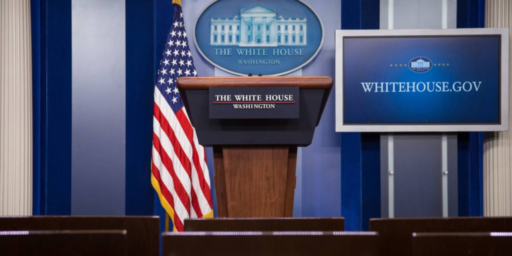
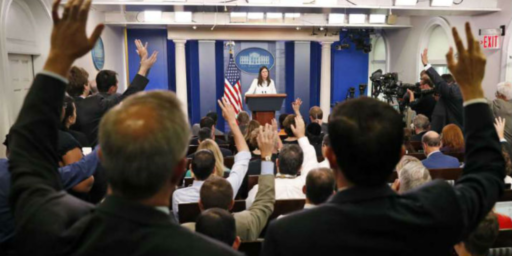
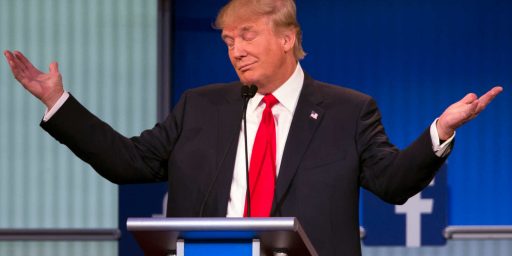
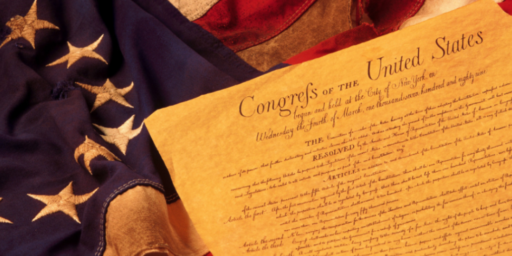
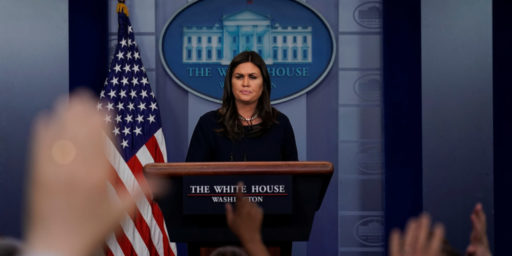
Well, when you regard the press as your arch-enemy, of course you hide from it.
The press’s actions are emblematic of a deeper delusion the public has – namely, that this is just an aberrant Administration and norms will be reasserted once this is all over one way or another. Too many “rational” people are refusing to wake up to the fact that this *is* the normal and is, in fact, the preferred method of doing things by those in power. Trump’s just been the only one who majored in Achievements in Ignorance and is able to get it done.
Serious question: other then to show they’re not like Trump, what’s the impetus for the next President – D or R – to resume press conferences? Clearly the press is going to just roll along with whatever happens so why bother? Other then tut-tutting, nothing can be done. Even if it could, it won’t. The WH doesn’t have to tell us jack other then what the Constitution and a handful of easily bypassed sunshine laws demand. We as a nation are not entitled to updates or real-time information – we’ve just gotten used to them over the decades. It’s only now that it’s threatening to go away do people realize what they’re about to lose.
Why would this admin want anyone knowing what they’re doing? Control of the press is necessary to autarchy, until they get it, they have to get by as best they can with this sort of thing.
If you were SHS why would you go out and lie to the Press for the President, when you are only going to make yourself into a fool?
Better she just goes out and lies to Fox, who is never ever going to call her out.
I’m by no means convinced this has been a negative development. The daily briefings had become news events in themselves, with major stories written about exchanges between Sanders and some reporter or other. Given the slightest excuse, most reporters will write stories about the importance of their own profession before they cover anything else.
One awful aspect of the briefings is that they made both reporters and editors lazy. What could be less demanding than writing stories day after day about what Spicer or Sanders said at the briefing? What kind of “analysis” could be easier than writing the same column every week bemoaning the White House’s lack of transparency?
Another insidious effect is that the briefings boost the ‘insider’ mentality that has corrupted the White House press corps and blurred the lines between politics and journalism, to the detriment of both. While events within the media are sometimes legitimate news stories, Washington journalists are far too inclined to assume they are elite leaders of the fourth estate whose doings are every bit as important as those of the politicians they are supposed to be reporting.
No government is transparent. They just vary in the strategies they use to manipulate and conceal. Trump’s crude hostility is a blessing, because it leaves the media little alternative to engaging in good old-fashioned investigative journalism if they want to retain public confidence. Something which at least some people in the US media seem finally to be realizing.
@Ken_L: And the alternative which is a cacophony of leaks from competing factions within the administration is just fine! Or maybe not.